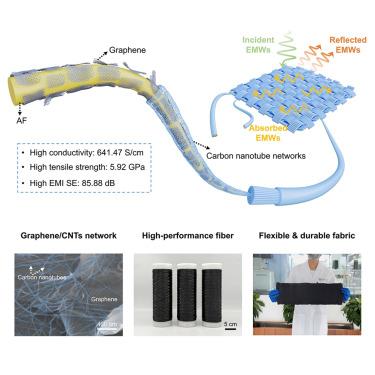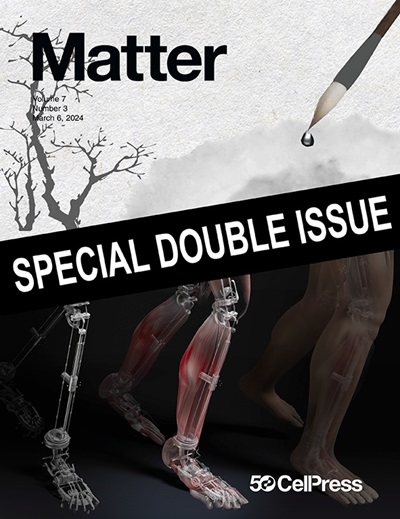用于电磁干扰屏蔽的任意纤维衬底上的碳烯材料的尺寸工程顺序装配
IF 17.5
1区 材料科学
Q1 MATERIALS SCIENCE, MULTIDISCIPLINARY
引用次数: 0
摘要
石墨烯和碳纳米管(CNTs)等碳烯材料表现出优异的电性能,使它们成为电磁干扰(EMI)屏蔽涂层的理想材料。然而,它们的疏水性和化学惰性性质给在亲水性或惰性纤维表面上均匀组装带来了挑战,通常需要表面处理或化学修饰。在这里,我们报告了一种尺寸工程策略,可以在纤维基底上制造坚固的导电碳纤维涂层。采用湿化学组装工艺,首先沉积石墨烯片作为基础层,然后依次集成碳纳米管。这种分层组装减少了石墨烯的褶皱,增强了sp2-碳的连续性。486 nm厚的碳烯涂层使芳纶纤维(AF)的电导率从0提高到641.47 S/cm,同时保持5.92 GPa的高抗拉强度。用这些涂层AFs编织的织物在X波段的电磁干扰屏蔽效能为85.88 dB。本研究提出了开发通用涂层的有效策略,重点介绍了其在电磁干扰屏蔽方面的应用。本文章由计算机程序翻译,如有差异,请以英文原文为准。


Dimension-engineered sequential assembly of carbonene materials on arbitrary fiber substrates for electromagnetic interference shielding
Carbonene materials such as graphene and carbon nanotubes (CNTs) exhibit exceptional electrical properties, making them promising for electromagnetic interference (EMI) shielding coatings. However, their hydrophobic and chemically inert nature poses challenges for uniform assembly onto hydrophilic or inert fiber surfaces, often requiring surface treatments or chemical modifications. Here, we report a dimension-engineering strategy to fabricate robust, conductive carbonene coatings on fiber substrates. Using a wet-chemistry assembly process, graphene sheets were first deposited as a base layer, followed by sequential integration of CNTs. This hierarchical assembly reduces graphene wrinkling and enhances sp2-carbon continuity. A 486-nm-thick carbonene coating boosted the conductivity of aramid fiber (AF) from 0 to 641.47 S/cm while maintaining a high tensile strength of 5.92 GPa. Fabrics woven from these coated AFs showed an EMI shielding effectiveness of 85.88 dB in the X band. This study presents an effective strategy for developing universal coatings, highlighting their applications for EMI shielding.
求助全文
通过发布文献求助,成功后即可免费获取论文全文。
去求助
来源期刊

Matter
MATERIALS SCIENCE, MULTIDISCIPLINARY-
CiteScore
26.30
自引率
2.60%
发文量
367
期刊介绍:
Matter, a monthly journal affiliated with Cell, spans the broad field of materials science from nano to macro levels,covering fundamentals to applications. Embracing groundbreaking technologies,it includes full-length research articles,reviews, perspectives,previews, opinions, personnel stories, and general editorial content.
Matter aims to be the primary resource for researchers in academia and industry, inspiring the next generation of materials scientists.
 求助内容:
求助内容: 应助结果提醒方式:
应助结果提醒方式:


